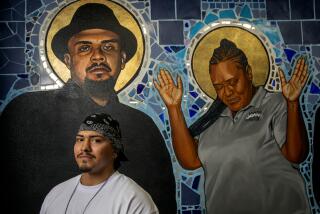Merger of two Black-led banks aims to help break a painful cycle
Los Angeles’ Broadway Federal Bank and Washington, D.C.’s City First Bank are merging to form the largest Black-led bank in the U.S., underscoring the challenges such banks have faced in generating enough capital to effectively serve their communities.
Black-owned and -led banks have long been caught in a difficult cycle: They tend not to have enough money to lend to help their communities build wealth, and the resulting dearth of wealth-building opportunities diminishes the money available to flow into the banks. Efforts to remedy that include the grass-roots #BankBlack movement — as well as the merger announced Wednesday.
To really make a difference in high-cost markets such as L.A. and D.C., banks need to be able to write bigger checks, particularly to fund projects such as multifamily affordable housing or to finance small businesses and nonprofits, said Brian Argrett, chief executive of City First Bank. Those three areas will be the combined bank’s main focuses, he said.
The deal merging Broadway Federal’s parent, Broadway Financial Corp., and City First’s parent, CFBanc Corp., will create a combined entity with more than $1 billion in assets. Described as a merger of equals, the deal is expected to close in the first quarter of 2021, and, like Broadway Financial, the resulting firm will be publicly traded.
The merger will give the combined bank more capital and capability, allowing it to “direct more capital through loans and into the underlying communities that we both serve,” said Argrett, who will be CEO of the new, yet-unnamed entity.
For years, many Black-owned and -led banks have been limited by their relative lack of assets.
Last year there were 21 such banks in the U.S., down from 48 in 2001, according to the Federal Deposit Insurance Corp. Those 21 banks had assets totaling $4.85 billion.
That same year, the 33 Latino-owned or -led banks in the U.S. had $109 billion in assets and the 72 Asian-owned or -led banks had $129 billion in assets. Those totals pale in comparison with the holdings of the nation’s major banks: In July, for example, Wells Fargo said it had $1.97 trillion.
Black-owned and -led banks need to increase the number of checking and savings accounts, business lines of credit, mortgages and other loans to “significantly move the needle,” said William Michael Cunningham, economist and CEO of consulting firm Creative Investment Research.
“The lack of Black wealth means that you don’t have a community asset base you can utilize to create larger Black financial institutions,” he said. “The money just isn’t there.”
The Great Recession of 2007-09 hit Black-owned and -led banks and their borrowers especially hard.
During that recession, median net wealth declined for Black families by 44.3%, compared with 26.1% for white families.
That disproportionate toll “had a filter effect onto Black businesses, including Black banks,” said Michael Neal, senior research associate in the Housing Finance Policy Center at the Urban Institute think tank.
With fewer assets, the banks cannot lend as much as larger financial institutions, particularly in areas such as mortgage lending, which helps homeowners build wealth and is also profitable for banks, Neal said.
Black-owned and -led banks also typically have a more limited selection of services, particularly those that help customers generate more wealth, such as brokerage services.
“The asset base is too small for them to have a measurable economic impact on the Black community,” Cunningham said. “That’s just the bottom line.”
There have been recent efforts to increase deposits. And streaming giant Netflix pledged in June to invest up to $100 million in financial institutions that support Black communities. But even that amount is not enough to “demonstrably and measurably improve the economic well-being of the Black community,” Cunningham said.
Black-owned banks arose as a response to racial hostilities toward Black Americans, according to Mehrsa Baradaran’s book “The Color of Money: Black Banks and the Racial Wealth Gap,” which documents the history and significance of those banks.
The first Black-owned bank in the U.S. grew out of Industrial Building and Savings Co., an institution that primarily invested in mortgage lending and whose first president was famed abolitionist Frederick Douglass. In its first four years, Industrial Building and Savings Co. helped finance 60 homes in Washington, D.C.
In 1888, Capital Savings Bank opened up, after Grover Cleveland was elected president. Black Americans feared that post-Civil War freedoms and opportunities could erode under the Democratic Party, especially in the South, according to a history published by the Federal Reserve Bank of Kansas City.
In its first year, Capital Savings Bank received $117,000 in deposits. That number quickly grew. Over its first four years in operation, the Washington, D.C.-based financial institution had a total of about $2 million in deposits, according to the Federal Reserve Bank of Kansas City.
“What we have accomplished in these brief years has been accomplished in the face of greater opposition that we have any reason to expect will confront us again,” the bank’s secretary told a reporter around its fifth year of operation, according to the Federal Reserve Bank of Kansas City.
Since then, Black-owned and -led banks have faced a host of challenges.
Some were forced by regulators to shut, even as larger financial institutions received government aid when they were near failure.
One example is Pittsburgh’s Dwelling House Savings and Loan Assn., which was closed by the Treasury Department’s Office of Thrift Supervision in 2009.
Months before its closure, the Office of Thrift Supervision had deemed the bank “critically undercapitalized” and gave it a deadline to fix the problem, according to the Pittsburgh Business Times. A bank official told the publication at the time that more than $3 million had been stolen from the bank through fraudulent transactions.
Just before its closure, Dwelling House had $13.4 million in assets, according to the FDIC. After it shut, its only location was turned into a PNC Bank branch.
In shutting some Black-owned banks, regulators “neglected to consider the social impact and the other services that these tiny, tiny institutions were providing to the Black community,” Cunningham said.
The philosophy of Boston-based OneUnited Bank, the largest Black-owned bank in the U.S., is based on a historical effort to harness the economic spending power of Black America and channel that power back into the community. In this spirit, the bank offers “second-chance checking” to customers who might not be able to open accounts elsewhere because of their imperfect banking histories.
“We want to give people an opportunity that wouldn’t otherwise have an opportunity to be successful,” CEO Kevin Cohee said.
Federal legislation is in the works that would provide more support for community development financial institutions and minority depository institutions, which include Black-owned and -led banks.
Introduced by Rep. Gregory Meeks (D-N.Y.), the bill would create, among other things, a program that would allow minority depository institutions to receive some deposits from certain Treasury Department accounts.
Investing in these institutions allows them to “address the immediate needs and concerns of not-for-profits and small businesses and regular community members,” Meeks said. “You will never have a level playing field if you don’t have the access to capital.”
Banks operating in lower-income communities typically need access to other resources, such as support from corporate America or government entities.
Efforts to create space for Black-owned banks — such as the federal Community Reinvestment Act, passed in 1977 to fight racial discrimination in lending — must be paired with concrete financial commitments to better support these institutions. Otherwise they simply wither away, OneUnited’s Cohee said.
One grass-roots movement aimed to do just that.
Launched in 2016 after fatal police shootings of Black men, the #BankBlack movement calls for Black people to deposit money into Black-owned banks to support the community.
The #BankBlack movement helped boost OneUnited’s customer base by at least 40,000 since the end of May, and customer service calls have increased 50% in that time. The company also saw a record $50 million in deposits, Cohee said.
But there are limits to what this movement can do. While the hashtag has brought attention to Black-owned banks, banks actually make money off loans rather than deposits, said author Baradaran, who is also associate dean and professor of law at UC Irvine’s law school.
“They don’t need deposits, they need lending opportunities,” she said. “Black banks need more capital. They need for these government programs to be helping them, rather than going to the big banks, big businesses.”
Cohee said OneUnited can’t rely solely on the #BankBlack movement, noting that the bank’s larger size and proprietary technology have led to its success.
Banks don’t exist in a vacuum, unhindered by the larger economic conditions its customers face. In “The Color of Money,” Baradaran argues that housing segregation and racist credit policies “create an inescapable economic trap for Black communities and their banks.”
“Black banking has been an anemic response to racial inequality that has yielded virtually nothing in closing the wealth gap,” Baradaran wrote.
Black-owned banks that operate on a community-based model often struggle because they seek to serve lower-income communities of color, where credit is poor due to a history of discrimination, OneUnited’s Cohee said.
“At the core of it, it’s racism,” he said. “Banks tend to perform better in places where people have more money.”
In spite of their limitations, Black-owned and -led banks are still key lenders for Black borrowers. Few brick-and-mortar banks exist in some rural parts of the U.S., as well as in some predominantly Black neighborhoods, resulting in so-called banking deserts. With no other options, residents sometimes are forced to lean on higher-priced financial services or predatory lenders.
“Black-owned banks are really serving a community that often finds it more difficult to get loans elsewhere,” Neal said. “Black banks can lend to people in neighborhoods that historically have experienced systemic racism and ... are just not getting the same amount of capital investment.”
More to Read
Inside the business of entertainment
The Wide Shot brings you news, analysis and insights on everything from streaming wars to production — and what it all means for the future.
You may occasionally receive promotional content from the Los Angeles Times.












